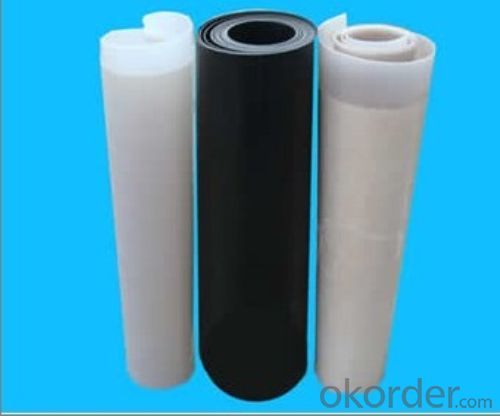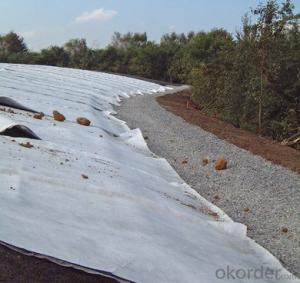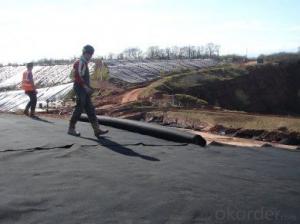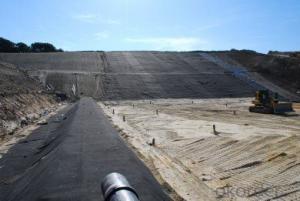Needle Punched Non-woven Geotextile Fabric Materials
- Loading Port:
- China main port
- Payment Terms:
- TT OR LC
- Min Order Qty:
- 1000 m²
- Supply Capability:
- 500000 m²/month
OKorder Service Pledge
OKorder Financial Service
You Might Also Like
Item specifice
Non Woven Geotextile Introduction:
Nonwoven geotextiles are manufactured from the extrusion of polypropylene fibres which are then laid down on a manufacturing "bed" and then needle punched to entangle the fibres such that a dimensionally stable product is formed. Some additional thermal treatment is then applied to further improve the strength of the geotextile. Because of this manufacturing process non-woven geotextiles are generally best used in applications of drainage, filtration and protection
Environment friendly construction material.
Unit Weight of Continuous Filament Nonwoven Geotextile
100g/m2, 150g/m2, 200g/m2, 250g/m2, 300g/m2, 350g/m2, 400g/m2, 450g/m2, 500g/m2, 600g/m2, 800g/m2 or customerized
Tensile strength comparation between short filament geotextile and Continuous filament geotextile
The tensile strength of filament geotextile is higher than short filament geotextile.
Photos:

Packaging & Shipping
Packing: PLASTIC FILM INSIDE, AND WOVEN BAG OUTSIDE
Shipping: About 15 days after receipt the deposit
specifications
geotextile fabric
permeability,filtration,easy for construction
ISO and CE certificate
Good quality and competitive price
Our Service
Quality assurance
1.On a regular basis or as per your request,we entrust national testing agencies to conduct quality inspections
2. Strictly in accordance with the ISO9001-2008 international quality system standard,we monitor and manage the whole process throughout production,quality testing,and measurement to ensure product quality
3. For quality-related construction delay or substandard construction(except for damage or losses due to customer’s responsibility or irresistible natural disasters),we have refunding,replacement,and repair services.We will respond to customers’ feedbacks on quality issues within 24 hours.
After-sales service
1.In order to provide customers with comprehensive technical support,we will provide technical and other related information upon request in a timely manner.
2.In required,we will appoint specialized technicians to the construction site to give technical trainings to construction people,and offer technical guidance throughout the whole construction process.
3.For damage due to shipment and delivery,after we receive the complaint,we will check the issure through provided pictures and videos.If our responsibility is confirmed,we wil offer free replacement.
4.When the construction is completed,as your request,our technical staff may participate in the final acceptance.
FAQ:
Q: What kind of payments does jenor support?
A: T/T, L/C, Cash are accepted.
Q: Do you charge for the samples?
A: Accordeing to our company policy, the samples are free, we only charge the freight fee. And we will return the freight fee during the next order.
Q: Can you produce according to customers' design?
A: Sure, we are professional manufacturer, OEM and ODM are both welcome.
Q: Do you have other products?
A: Yes, please check the pictures:
- Q:How do geotextiles contribute to the cost-effectiveness of construction projects?
- Geotextiles contribute to the cost-effectiveness of construction projects by providing various benefits. They act as a barrier against soil erosion, reducing the need for expensive erosion control measures. Geotextiles also enhance soil stability, allowing for the use of less expensive and readily available fill materials. Additionally, they improve drainage and filtration, minimizing the need for costly drainage systems. Overall, geotextiles help optimize construction processes, reduce material and labor costs, and extend the lifespan of structures, making them a cost-effective choice for construction projects.
- Q:Can geotextiles be used for shoreline protection?
- Yes, geotextiles can be used for shoreline protection. Geotextiles are often employed to prevent erosion and stabilize the soil along shorelines. They act as a barrier, preventing soil from being washed away by waves and currents. Additionally, geotextiles can help with vegetation growth, which further aids in shoreline stabilization.
- Q:Can geotextiles be used for reinforcement of embankments?
- Yes, geotextiles can be used for reinforcement of embankments. Geotextiles are commonly used in civil engineering projects to improve the stability and strength of embankments. They provide reinforcement by distributing and dissipating forces, preventing soil erosion, and enhancing the overall performance and longevity of the embankment structure.
- Q:Geotextile types and role of geotextiles which types, respectively, what role, filament geotextile, short geotextile, composite geotextile, respectively, what role? More
- Geotextile types and role of geotextiles which types, respectively, what role, filament geotextile, short geotextile, composite geotextile, respectively, what role? More
- Q:Textile geotextile lap length how much
- Lap width is generally 10-15cm
- Q:What are the advantages of using geotextiles in storm surge protection systems?
- Geotextiles offer several advantages in storm surge protection systems. Firstly, they can effectively control erosion by stabilizing soil and preventing it from being washed away during heavy storms. Secondly, geotextiles act as a filter by allowing water to pass through while retaining sediment, thus reducing the risk of clogging drainage systems. Additionally, they provide reinforcement to structures, such as retaining walls or revetments, enhancing their stability and durability against wave action. Moreover, geotextiles are lightweight and easy to install, making them a cost-effective solution for storm surge protection.
- Q:Can geotextiles be used in seawall construction?
- Yes, geotextiles can be used in seawall construction. Geotextiles are commonly used as a reinforcing material in seawalls to provide additional strength and stability. They help control erosion, prevent soil movement, and provide filtration to ensure proper drainage in seawall structures.
- Q:Geotextile drainage network and geotextile how to heat stick
- Geotextile and geotextile crimp part of the use of sewing or hot air welding. Hot air welding is the connection method of filament geotextile, that is, with the hot air gun on the connection of two pieces of cloth instantaneous high temperature heating, so that part of the molten state, and immediately use a certain external force to make it firmly together. In the case of wet (rain and snow) weather can not be hot adhesive connection, geotextile should take another method of a suture connection method, that is, with a dedicated sewing machine for two-wire suture connection, and the use of anti-chemical UV suture.
- Q:How do geotextiles improve the performance of railway tracks?
- Geotextiles improve the performance of railway tracks by providing a stable and durable foundation. They act as a barrier between the subgrade and the ballast, preventing the mixing of materials and reducing the risk of track settlement. Geotextiles also enhance drainage, preventing water accumulation and maintaining track stability. Additionally, they distribute load more evenly, reducing the pressure on the subgrade and minimizing the risk of track deformations. Overall, geotextiles enhance the longevity, safety, and performance of railway tracks.
- Q:What are the advantages of using geotextiles in stormwater management systems?
- Geotextiles offer several advantages in stormwater management systems. Firstly, they provide effective sediment filtration, preventing soil erosion and the accumulation of pollutants in water bodies. Secondly, they enhance soil stability by reinforcing the ground and minimizing the risk of slope failures. Additionally, geotextiles promote water infiltration and drainage, reducing the chances of flooding and ponding. They are also cost-effective as they require less maintenance and have a longer lifespan compared to traditional erosion control methods. Overall, geotextiles play a crucial role in improving the overall performance and sustainability of stormwater management systems.
1. Manufacturer Overview |
|
|---|---|
| Location | |
| Year Established | |
| Annual Output Value | |
| Main Markets | |
| Company Certifications | |
2. Manufacturer Certificates |
|
|---|---|
| a) Certification Name | |
| Range | |
| Reference | |
| Validity Period | |
3. Manufacturer Capability |
|
|---|---|
| a)Trade Capacity | |
| Nearest Port | |
| Export Percentage | |
| No.of Employees in Trade Department | |
| Language Spoken: | |
| b)Factory Information | |
| Factory Size: | |
| No. of Production Lines | |
| Contract Manufacturing | |
| Product Price Range | |
Send your message to us
Needle Punched Non-woven Geotextile Fabric Materials
- Loading Port:
- China main port
- Payment Terms:
- TT OR LC
- Min Order Qty:
- 1000 m²
- Supply Capability:
- 500000 m²/month
OKorder Service Pledge
OKorder Financial Service
Similar products
New products
Hot products
Hot Searches
Related keywords
































